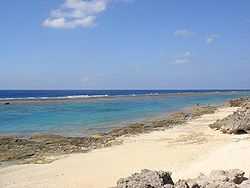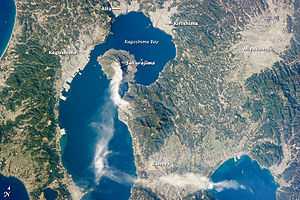China, Kagoshima
| China 知名町 | |||
|---|---|---|---|
| Town | |||
|
Yakomo Beach | |||
| |||
 Location of China in Kagoshima Prefecture | |||
 China
| |||
| Coordinates: 27°21′0″N 128°34′0″E / 27.35000°N 128.56667°ECoordinates: 27°21′0″N 128°34′0″E / 27.35000°N 128.56667°E | |||
| Country | Japan | ||
| Region | Kyushu (Amami Islands) | ||
| Prefecture | Kagoshima Prefecture | ||
| District | Ōshima | ||
| Government | |||
| • -Mayor | Masamori Hirayasu | ||
| Area | |||
| • Total | 53.29 km2 (20.58 sq mi) | ||
| Population (June 1, 2013) | |||
| • Total | 6,506 | ||
| • Density | 122/km2 (320/sq mi) | ||
| Time zone | Japan Standard Time (UTC+9) | ||
| - Tree | Banyan | ||
| -Flower | Hibiscus | ||
| Phone number | 0997-93-3111 | ||
| Address | 307, China, China-chō, Ōshima-gun, Kagoshima-ken 891-9295 | ||
| Website |
www | ||
China (知名町 China-chō, IPA: [tɕina]) is a town located on Okinoerabujima, in Ōshima District, Kagoshima Prefecture, Japan.
As of June 2013, the town has an estimated population of 6,506 and a population density of 122 persons per km². The total area is 53.29 km².[1][2]
Geography
China is located on the southern end of Okinoerabujima.[2] The town's one kilometre-long Yakomo Beach is about five minutes from the harbor by bus.[3] NHK describes it as one of the most beautiful beaches on the island.[4] Other natural seaside attractions include Ushishi Beach (ウシシ海岸) and Tamina Cape (田皆岬).[1]
Another tourist attraction in the town is the 3,500-meter long Shōryū Caves (昇竜洞). They were discovered in 1963 and partially opened to the public that same year.[5]
Climate
The climate is classified as humid subtropical (Köppen climate classification Cfa) with very warm summers and mild winters. Precipitation is high throughout the year, but is highest in the months of May, June and September. The area is subject to frequent typhoons.
Surrounding municipalities
History
China Village was founded in 1888. As with all of Okinoerabujima, the village came under the administration of the United States from 1 July 1946 to 25 December 1953. It was promoted from village to town status in 1946.[6]
Economy
Sugar cane, sweet potato, and peanut farming are popular. Floriculture is also practiced. A total of 1,958 hectares of land are under cultivation in the town.[7] However, due to the lack of local jobs, there has been an outflow of residents.[1]
Transportation
China is located on Kagoshima Prefectural Route 84. The only airport serving the area, the Okinoerabu Airport, is about 80 minutes away in neighboring Wadomari. There also is a ferry to the prefectural capital Kagoshima from China Port.[2] It takes between 17 and 18 hours.[1]
Education
Education in China is controlled by the five members of the Education Committee, whose members serve four year terms. As of 2008, the members of the committee are Kasuga Tetsuyū, Nakada Akimi, Akita Yoshihiro, Miyayama Kazuo, and Ooyama Osamu.[8] The town has five kindergartens, five primary schools, two middle schools, and one senior high school.[1] The high school, Okinoerabu High School, was formed in 1949 through the merger of China High School and Wadomari High School; it maintains campuses in both towns.[9]
| Name | Number of students | |
|---|---|---|
| Kindergartens | ||
| China Kindergarten | 39 | |
| Sumiyoshi Kindergarten | 13 | |
| Tamina Kindergarten | 9 | |
| Kamishiro Kindergarten | 0 (classes suspended) | |
| Shimohirakawa Kindergarten | 25 | |
| Primary schools | ||
| China Primary School | 222 | |
| Sumiyoshi Primary School | 53 | |
| Tamina Primary School | 35 | |
| Kamishiro Primary School | 23 | |
| Shimohirakawa Primary School | 109 | |
| Middle schools | ||
| China Middle School | 129 | |
| Tamina Middle School | 65 | |
| High schools | ||
| Okinoerabu High School[11] | 337[12] | |
There is also a municipal library.[13]
Public Facilities
There are two medical clinics, four dental clinics, and one hospital in the town. There are also two nursing homes.[1]
The Ōyama Japan Self-Defense Forces base is located about 10 minutes from the center of town by bus, near the Ōyama Camping Grounds.[14]
Culture
China has a distinctive form of lion dance, believed to have been transmitted from Okinawa in the 18th century.[15] Another local traditional dance is the Daija-Odori (大蛇踊り, literally, "big snake dance"), consisting of a snake puppet suspended in mid-air from a frame and manipulated by strings. It is performed to a taiko drum and sanshin (Okinawan three-stringed banjo) accompaniment.[16][17]
Popular local dishes include the traditional tofu-misozuke, prepared by drying tofu in the sun and then adding miso. A more recent innovation adds kimchi to the dish.[2]
External links
![]() Media related to China, Kagoshima at Wikimedia Commons
Media related to China, Kagoshima at Wikimedia Commons
- Official website in Japanese
Notes
- ↑ 1.0 1.1 1.2 1.3 1.4 1.5 知名町 (China Town), Kagoshima Prefecture Government, retrieved 2009-03-20
- ↑ 2.0 2.1 2.2 2.3 鹿児島の観光・自然・歴史・宿泊・交通など旅行に役立つ情報をお届けします。, Kagoshima Prefecture: Tourism Division, 2007, archived from the original on 2007-11-21, retrieved 2009-03-20
- ↑ "屋子母海岸 (Yakomo Beach)", Japan Tourism Agency, 2006, retrieved 2009-03-20
- ↑ "知名町立知名小学校 (China Municipal Primary School)", 情報WAVEかごしま, NHK, 2008-01-30, retrieved 2009-03-20
- ↑ 昇竜洞:太古の謎を秘めた幻想の世界, China Town Office, retrieved 2009-03-20
- ↑ 沿革/町章/町木/町花, China Town Office, retrieved 2009-03-20
- ↑ 平成19年度農畜産物生産計画 (2008 agricultural production statistics), China Town Office, 2008, retrieved 2009-03-20
- ↑ 教育行政の基本方針&教育委員 (Basic Educational Policy and Education Committee Members), China Town Office
- ↑ 沖永良部高校 沿革, Kagoshima Prefectural Institute for Education Research, retrieved 2009-03-22
- ↑ 学校紹介 (Schools Introduction), China Town Office, retrieved 2009-03-20
- ↑ 鹿児島県立 沖永良部高等学校 (Kagoshima Prefectural Okinoerabu High School), Kagoshima Prefectural Institute for Education Research, retrieved 2009-03-22
- ↑ 沖永良部高校とは (About Okinoerabu High School), Kagoshima Prefectural Institute for Education Research, retrieved 2009-03-22
- ↑ 知名町立図書館 (China Municipal Library), China Town Office, retrieved 2009-03-20
- ↑ 大山野営場 (Ōyama Camping Grounds), China Town Office, retrieved 2009-03-20
- ↑ 瀬利覚の獅子舞 (Serikaku Lion Dance), Kagoshima Prefectural Office, retrieved 2009-03-20
- ↑ 上平川の大蛇踊り (The Daija-Odori of Kamihirakawa), Kagoshima Prefectural Office, retrieved 2009-03-20
- ↑ 上平川大蛇踊り (Kamihirakawa's Daija-Odori), Japan Tourism Agency, 2006, retrieved 2009-03-20
| |||||||||||||||||||||


